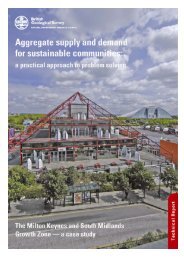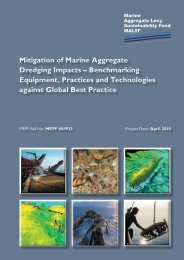creating environmental improvements through biodiversity
creating environmental improvements through biodiversity
creating environmental improvements through biodiversity
Create successful ePaper yourself
Turn your PDF publications into a flip-book with our unique Google optimized e-Paper software.
Sustainable Aggregates Creating Environmental Improvements <strong>through</strong> Biodiversity<br />
(MIRO questionnaire: success measured by numbers visiting the website, numbers of copies of report in<br />
circulation, reference to the project by stakeholders and in relevant media)<br />
Impacts (Potential):<br />
Wide availability of the document and use of the website by the minerals industry should increase awareness<br />
of the potential for habitat creation on minerals sites, as well as providing a practical starting point for those<br />
unused to the process. Word of mouth within the industry and use of the website as an interactive forum<br />
could help to instigate a cultural shift towards consideration of conservation end-uses.<br />
MIRO questionnaire: no unrealised benefits<br />
Potential Expansion:<br />
The GIS model may be expanded to consider the end-uses of potential minerals sites that are not yet active,<br />
as most currently active sites will already have an agreed end-use.<br />
The Minerals Restoration Potential Project is being followed up by the Nature After Minerals Project, which<br />
will review relevant literature and organise a series of workshops aimed at minerals planners.<br />
(MIRO questionnaire: If sufficient time had been available, a tool to allow the investigation of potential<br />
end-uses for future mineral sites would be beneficial. Numerous stakeholders requested this, but time and<br />
resource constraints prevented its production.<br />
MIRO questionnaire: if funding was available would – deliver the tool described above; use results of the<br />
project to advocate benefits of habitat creation as an end-use to mineral planners - doing this <strong>through</strong><br />
NE ALSF funding this year. Numerous other opportunities follow on from the project, on which work has<br />
already begun. Overall aim of the work is to facilitate and support more and higher-quality habitat creation<br />
on mineral sites.)<br />
Dissemination:<br />
The interactive website provides a good means of information dissemination. The Nature After Minerals<br />
project will provide a focus for interaction with minerals planners and dissemination of advice. The Nature<br />
After Minerals advocacy report has been distributed to planning authorities.<br />
WATER-BASED QUARRY RESTORATION – METHODOLOGIES,<br />
TECHNOLOGIES AND APPROACHES (MIRO MIST, HAFREN WATER)<br />
P. Ellis, C. C. Leake (Hafren Water), M. Hammond (Wildlife Consultant),<br />
R. Smithyman, D. Barratt (Pleydell Smithyman), D. Sargent (Landscape Agency),<br />
L. Hutchinson (Freshwater Solutions). March 2007 (draft version 1)<br />
Project Type: Technical background and advice. Case studies<br />
Site: Seven sites within North Yorkshire, in the Swale and Ure Washlands and the Yorkshire Dales<br />
Project Aim:<br />
To provide practical and multi-disciplinary guidance on technical issues associated with the water<br />
environment to aid in the design of future water-based restoration schemes. To inform the planning process<br />
such that restoration schemes could be tailored to address local issues such as low flows, scarce water<br />
resources, flooding, landscape setting and ecological diversity.<br />
Main Methods:<br />
Review of methodology and approaches used for water-based restoration, <strong>through</strong> published literature and<br />
discussions with interested parties<br />
Case studies of sites in different settings – input from experts in each related field<br />
Steering group of partner members set up to monitor progress and provide input<br />
60

















